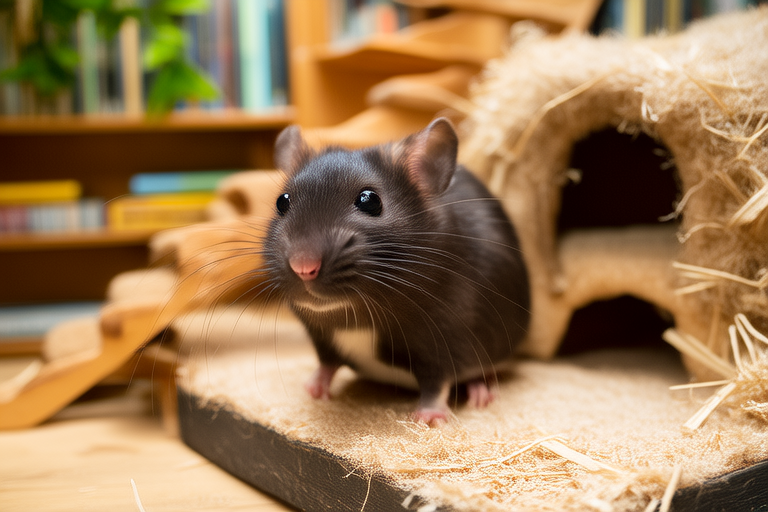How to Create the Perfect Habitat for Your Curious Fancy Rat Pal
Fancy rats are intelligent, social, and highly active creatures that require a stimulating environment to thrive. Creating the perfect habitat for your rat involves careful consideration of various factors, from cage size and bedding to toys and diet. This guide will walk you through everything you need to know to design a space that keeps your furry friend happy and healthy.
Selecting the Right Cage Size and Type
The first step in creating the perfect habitat for your fancy rat is choosing the right cage. Rats are curious and active animals that need plenty of space to move around and explore. A good rule of thumb is to provide at least 24 square inches per rat. For a single rat, a cage with dimensions of 24 inches by 18 inches by 12 inches is ideal. However, if you plan to have multiple rats, consider getting a larger cage or connecting multiple cages to provide ample space for each animal.
When it comes to cage types, wire cages are popular choices because they allow for better air circulation. Ensure that the wire mesh is small enough to prevent escape but large enough to allow your rat to stretch its legs fully. Avoid cages made of plastic, as rats can chew through them easily. Additionally, look for cages with easy-to-clean surfaces and sturdy construction to withstand the playful antics of your curious rat.
Essential Bedding Materials
Choosing the right bedding is crucial for maintaining a clean and comfortable environment for your rat. Opt for soft, absorbent materials like paper-based bedding, which is safe, dust-free, and easy to clean. Avoid cedar and pine shavings, as these can irritate your rat’s respiratory system. Additionally, provide nesting material such as shredded paper or fabric to allow your rat to build cozy nests.
Necessary Toys and Accessories for Mental Stimulation
Rats are naturally curious and enjoy exploring their surroundings. Providing a variety of toys and accessories is essential to keep your rat mentally stimulated and prevent boredom. Consider adding tunnels, hammocks, and chew toys to encourage exploration and play. Puzzle feeders can also be a fun way to engage your rat while providing mental challenges. Rotate toys periodically to keep things interesting and prevent overuse of any particular item.
Dietary Needs and Feeding Stations
A balanced diet is vital for the health and longevity of your fancy rat. A high-quality rat food mix that includes seeds, grains, and pellets is a great starting point. Supplement this with fresh fruits and vegetables, but avoid giving too much fruit due to its sugar content. Always provide fresh water daily, either in a sipper bottle or a heavy bowl that won’t tip over.
Feeding stations should be placed away from the litter area to maintain cleanliness. Consider using ceramic dishes that are less likely to be tipped over by your active rat. Additionally, ensure that the food dish is easy to access and clean.
Proper Ventilation and Temperature Control
Proper ventilation is crucial for maintaining a healthy environment for your rat. Ensure that the cage has adequate airflow, especially if you choose a wire cage. Avoid placing the cage in direct sunlight or near heat sources, as rats prefer cooler temperatures between 65 and 75 degrees Fahrenheit. Use a thermometer to monitor the temperature and adjust accordingly.
Safety Precautions to Prevent Injuries
To prevent injuries, ensure that the cage has no sharp edges or protruding wires. Check regularly for signs of wear and tear, and replace damaged items immediately. Provide soft bedding and nesting material to cushion falls and prevent injuries from rough surfaces. Additionally, supervise your rat during playtime outside the cage to prevent accidents.
Cleaning and Maintenance Tips
Maintaining a clean habitat is essential for your rat’s health. Clean the cage weekly, removing soiled bedding and replacing it with fresh material. Wash food and water bowls daily to prevent bacterial growth. Disinfect the cage thoroughly every few months, using pet-safe disinfectants and allowing it to dry completely before replacing bedding and accessories.
How to Introduce Changes to the Habitat Without Stressing the Rat
Introducing changes to your rat’s habitat can be stressful, especially if done suddenly. To minimize stress, make gradual changes over time. For example, add new toys one at a time and observe your rat’s reaction before introducing more. When changing bedding, mix old and new materials initially to help your rat adjust to the new scent. If you’re moving to a new home, create a familiar space in the new location before transferring your rat to reduce anxiety.
In conclusion, creating the perfect habitat for your fancy rat involves careful planning and attention to detail. By selecting the right cage size, providing appropriate bedding and toys, ensuring proper nutrition, and maintaining a clean environment, you can provide your curious and active rat with a stimulating and comfortable living space. Remember to consider your rat’s natural behaviors and needs throughout the process to ensure a happy and healthy life for your furry friend.
